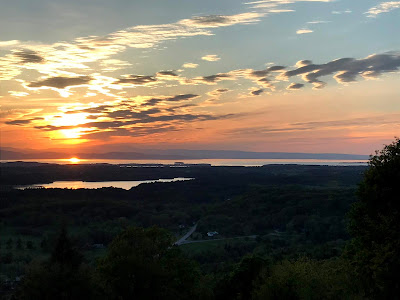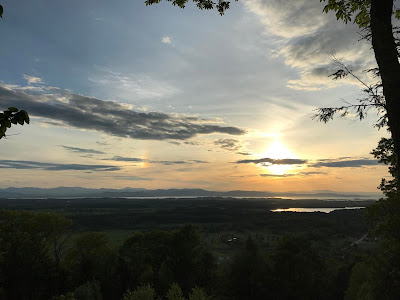Sunday.
To Nobscot with W. E. C.
This is the third windy
day following the two days’rain. A washing day, such as we always have at this
season, methinks.
The grass has sprung up as by magic since the rains. The
birds are heard through the pleasant dashing wind, which enlivens everything.
It is clear June, the first day of summer.
The rye, which, when I last looked,
was one foot high, is now three feet high and waving and tossing its heads in
the wind. We ride by these bluish-green waving rye fields in the woods, as if
an Indian juggler had made them spring up in a night. Why, the sickle and
cradle will soon be taken up. Though I walk every day I am never prepared for
this magical growth of the rye. I am advanced by whole months, as it were, into
summer.
Sorrel reddens the fields. Cows are preparing the milk for June butter.
Already the falling apple blossoms fill the air and spot the roads and fields,
and some are already turned dark with decay on the ground.
With this warmth and
wind the air is full of haze, such as we have not had before.
The lilac is
scented at every house.
The wood pewee’s warm note is heard.
We ride through
warm, sandy shrub oak roads, where the Viola pedata blues the edge of the path,
and the sand cherry and the choke-cherry whiten it. The crickets now first are
generally heard. Houstonias whiten the fields and are now in their prime. The
thorn bushes are full of bloom.
Observed a large sassafras tree in bloom, – a
rich lemon (?) yellow.
Left our horse at the Howe tavern. The oldest date on
the sign is “ D. H. 1716. ” An old woman, who had been a servant in the family
and said she was ninety-one, said this was the first house built on the spot.
Went on to Nobscot. Very warm in the woods, — and hear the hoarse note of the
tanager and the sweet pe-a-wai, — but pleasantly breezy on the bare hilltops.
Can’t see the mountains.
Found an abundance of the Viola Muhlenbergii (debilis of Bigelow), a stalked violet, pale blue and bearded.
The krigia out,
a redder, more July, yellow than the dandelion; also a yellow Bethlehem-star
and ribwort; and the mountain cranberry still here and there in blossom, though
for the most part small berries formed.
An abundance of saxifrage going to seed,
and in their midst two or three looking densely white like the pearly
everlasting — round dense white heads, apparently an abortion, an abnormal
state, without stamens, etc., which I cannot find described.
The pastures on
this hill and its spurs are sprinkled profusely with thorny pyramidal apple
scrubs, very thick and stubborn, first planted by the cows, then browsed
by them and kept down stubborn and thorny for years, till, as they spread,
their centre is protected and beyond reach and shoots up into a tree, giving a
wine-glass form to the whole; and finally perchance the bottom disappears and
cows come in to stand in the shade and rub against and redden the trunk. They
must make fine dark shadows, these shrubs, when the sun is low; perfectly pyramidal,
they are now, many of them. You see the cow-dung every where now with a hundred
little trees springing up in it. Thus the cows create their own shade and food.
This hill, Nobscot, is the summit of the island (?) or cape between
the Assabet and Musketaquid — per haps the best point from which to view the
Concord River valley. The Wayland hills bound it on the east; Berlin, Bolton, [and] Harvard hills on the west. The Sudbury meadows, seen here and there in
distance, are of a peculiar bluish green.
This is the first truly lively summer
Sunday, what with lilacs, warm weather, waving rye, slight dusty sandy
roads in some places, falling apple blossoms, etc., etc., and the wood pewee.
The country people walk so quietly to church, and at five o’clock the farmer
stands reading the newspaper while his cows go through the bars.
I ought
perhaps to have measured the great white oak by Howe’s.
A remarkably thick
white pine wood this side of Willis’s Pond ! !
...
Our quince blossomed yesterday.
Saw many low blackberries in bloom to-day
H. D. Thoreau, Journal, May 22, 1853
The wood pewee’s warm note is heard. See May 22, 1854 ("I hear also
pe-a-wee pe-a-wee, and then occasionally
pee-yu, the first syllable in a different and higher key emphasized, — all very sweet and naive and innocent") See also May 17, 1853 ("I hear the wood pewee, —
pe-a-wai. The heat of yesterday has brought him on."); May 17, 1854 ("Hear the wood pewee, the warm weather sound."). And see
A Book of the Seasons, by Henry Thoreau,
the Eastern Wood-Pewee
Already the falling apple blossoms fill the air and spot the roads and fields. See
May 17, 1853 ("The air filled with the sweetness of apple blossoms ( this is blossom week )");
May 20, 1854 ("Methinks we always have at this time those washing winds as now, when the choke-berry is in bloom, — bright and breezy days blowing off some apple blossoms”);
May 25, 1852 (It is blossom week with the apples.”);
May 27 1852 ("The road is white with the apple blossoms fallen off, as with snowflakes.”);
June 1, 1855 ("A very windy day, . . . scattering the remaining apple blossoms.”)
Found an abundance of the
Viola Muhlenbergii (
debilis of Bigelow), a stalked violet, pale blue and bearded. See May 22, 1856 ("To
Viola Muhlenbergii, which is abundantly out; how long? A small pale-blue flower growing in dense bunches, but in spots a little drier than the
V. cucullata and
blanda.") See also
A Book of the Seasons, by Henry Thoreau,
the Violets
The pastures on this hill and its spurs are sprinkled profusely with thorny pyramidal apple scrubs, very thick and stubborn, first planted by the cows, then browsed by them and kept down stubborn and thorny for years, till, as they spread, their centre is protected and beyond reach and shoots up into a tree. See
October 28, 1857 ("I see some shrubs which cattle have browsed for twenty years, keeping them down and compelling them to spread, until at last they are so broad they become their own fence and some interior shoot darts upward and bears its fruit. ")












